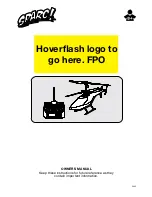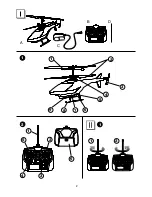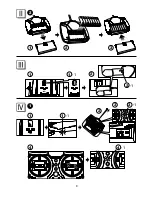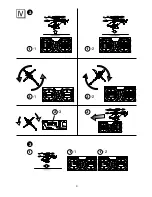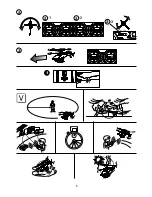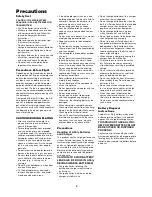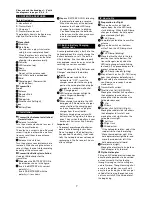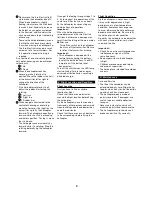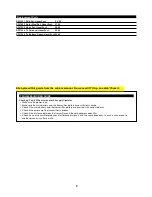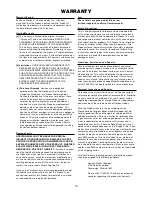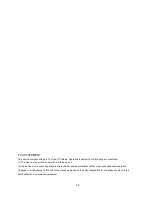
6
Safety first
CAUTION: TO AVOID BATTERY
LEAKAGE. (OF AA BATTERIES FOR
TRANSMITTER)
• Use AA batteries for transmitter.
• Make sure the batteries are inserted
with correct polarity and follow the
toy and battery manufacturer’s
instructions.
• After use, remove the batteries from
the transmitter to store.
• Do not attempt to short-circuit,
charge, disassemble or heat batteries.
Do not dispose of batteries in fire or
get them wet.
• If battery fluid contacts your eyes, skin
or clothes, immediately wash them
with water and consult a doctor.
• Do not mix new and old batteries
together in the transmitter.
Precautions Before Flight
Depending on flight condition or due to
improper control, flying a helicopter can
be hazardous resulting in unforeseen
accidents such as bodily injury and
property damage, and the helicopter
operator shall be held responsible for
such accident. To be a responsible op-
erator, you are recommended to obtain
adequate insurance before playing with
the helicopter.
Compared with other R/C toys, the R/C
helicopter is perceived as harder to
control. Inexperienced operators can
get skilled after training, though they
may not successfully fly the helicopter at
the beginning. So do not give up, and
have more training.
CAUTIONS DURING PLAYING
• After use, store the helicopter in a
place out of the reach of children
years old or younger.
• For avoiding hazards from improper
use, this helicopter is not intended
for children under 15 years old. Also,
children are recommended to use this
helicopter under adult’s supervision.
• Make sure you have plenty of open
space in all directions. Fly the helicop-
ter in a safe area away from people,
pets, etc.
• Do not throw the helicopter toward a
person, otherwise an injury may occur.
• Do not store the helicopter in a place
near a heater or like where tempera-
ture rises (e.g., a shut up car in
summer).
• Do not fly the helicopter in windy days
or when it thunders.
• Fly the helicopter away from roads,
railways and power lines, and avoid
crowded and narrow areas.
• If the helicopter gets stuck on a tree,
building or power line, do not climb to
retrieve it. Contact the owner or the
power company in such a case.
• Do not bring your face or hands
near the rotating rotor. For safety’s
sake, you are recommended to wear
goggles.
• Do not use a helicopter if it is unrecov-
erably damaged or distorted.
• Keep supervision to the helicopter
in flight.
• Do not touch charging terminals (i.e.,
the metal part) on the helicopter body
and the charger.
• The helicopter is intended for outdoor
use only.
• Do not point the transmitter antenna
toward a person’s or animal’s head,
otherwise an unforeseen accident may
occur. Also, do not bend the antenna.
• Do not keep looking at the blinking
LEDs on the transmitter and the heli-
copter body. Doing so may cause you
to feel uncomfortable.
• Never attempt to disassemble or
modify the helicopter.
• Do not bend or pull the components
with a strong force.
• Do not operate the helicopter with the
main rotor locked.
• Do not drop or impact.
• Do not give an impact to batteries
and the charger during charging.
Otherwise, the charging port may be
damaged.
• When charging is complete, remove
the charger connector from the charg-
ing port on the helicopter then unplug
the charger from the wall outlet.
• Check if a near transmitter produces
interference or signals with the same
frequency. In such a case, move to
another place or try after a while.
Precautions
Handling of LiPoly Batteries
and Charger
This product contains high-performance
Lithium Polymer batteries. The battery
features large capacity and high voltage
and has a lightweight design, which is
best suitable for use in R/C helicopters.
Because of the extremely large energy
content, be sure to handle the battery
with due care.
CAUTION: TO AVOID BATTERY
LEAKAGE. (OF BUILT-IN LiPoly
RECHARGEABLE BATTERIES)
• Charge batteries following the
battery and charger manufacturer’s
instructions.
• Charge batteries with the included
charger at the first use.
• Do not charge batteries with a charger
other than the included one.
• Do not charge batteries other than the
built-in LiPoly battery with the included
charger or use the charger as the
power source for other equipment.
• Do not charge batteries in a place
within the reach of small children.
• Do not give an impact to batteries and
the charger during charging
• Do not re-peak a LiPoly battery that
has peaked, otherwise the battery may
bedegraded. LiPoly batteries have a
low natural discharge rate, it does not
require recharging in the first one or 2
hours after a charge.
• When charge is complete, unplug the
charger from the wall outlet.
• After use, be sure to turn the switch
off. Failure to do so may adversely
affect batteries, resulting in disabled
charge.
• Do not short circuit battery terminals,
otherwise the battery may swell and
get hot, leading to a danger.
• Do not wet batteries, heat, disassem-
ble or modify them. Do not dispose of
batteries in fire.
• Do not use, store or charge batter-
ies in a place near a heater, or in high
temperature or humidity condition.
• When the use out of batteries be-
comes shorter and shorter, it is most
likely time to replace the battery.
Contact our service representative in
such a case.
Battery Disposal
Instructions
The built-in LiPoly battery, when used
under normal conditions, is capable of
approx. 200 charge/discharge cycles.
THIS PRODUCT USES A LITHI-
UM POLYMER BATTERY. MUST
BE RECYCLED OR DISPOSED
PROPERLY.
Contact your local area office of solid
waste management or other appropriate
local agency for information. Do not at-
tempt to disassemble the battery before
disposal.
Precautions


